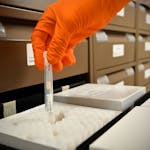SAN DIEGO – She first noticed the odd rash in February and figured it probably had something to do with her clothing.
A mammogram showed no internal warning signs, so Elaine Deboe carried on with her busy life working for Caltrans and enjoying time with her large extended family. "I didn't think too much of it," she said.
By the fall, the rash had spread, taking on a bumpy, orange-peel texture. Her doctor referred her to a dermatologist who diagnosed inflammatory breast cancer.
Suddenly, what seemed like an annoyance was an aggressive threat. "The toughest part has been not knowing what my outcome is going to be," Deboe, 56, said.
She is among a few with this particularly insidious form of breast cancer that presents not as a lump embedded deeply in tissue but as an anomaly on the surface.
"Inflammatory breast cancer presents more with a reddening of the skin of the breast, a swelling of the skin of the breast, kind of a heaviness, sometimes a tenderness of the breast," said Dr. Thomas Buchholz, medical director of Scripps MD Anderson Cancer Center.
According to the National Cancer Institute, inflammatory breast cancer makes up 1 to 5% of all invasive breast cancer cases. The American Cancer Society estimates the disease will be diagnosed in 3,000 to 13,500 American women this year.
In 2006, Buchholz was part of a team at M.D. Anderson in Houston that founded the first center dedicated to studying why this relatively rare condition surfaces in some women but not others. More than a decade later, Scripps, in a collaboration with Anderson, is starting its own center with a goal of sharing data.
Inflammatory breast cancer is considered particularly aggressive, blocking the lymph vessels in the skin of the breast and causing the swelling and redness. Progression can occur in weeks or months, meaning that the window to seek treatment can be small, especially as the condition's rarity means that primary care doctors often think they're dealing with a bacterial infection and prescribe antibiotics.
Given the speed, Buchholz said, treatment will often be more aggressive. After chemotherapy halts the spread, radiation treatments follow. He said IBC patients tend to be younger than average.
Research efforts have found that inflammatory breast cancer tumors often have the same genetic characteristics as tumors that grow more slowly and have various sensitivities to certain types of hormone-based therapy.
Why, then, do some cases become inflammatory? The current thinking, Buchholz said, is that there is something present in the "micro environment" of some women, in the basic chemistry of their bodies, that triggers inflammation. "Why certain women have a microenvironment that predisposes tumor cells to become more like inflammatory breast cancer rather than regular breast cancer is still unknown," Buchholz said.
But Scripps and M.D. Anderson are building up a store of information to help answer that question. Buchholz said, "We take careful histories about pregnancies and breast feeding and different types of exposures. We are looking for unique patterns within the IBC population so that we can begin to identify those factors that may have some bearing on who is affected and who isn't."




